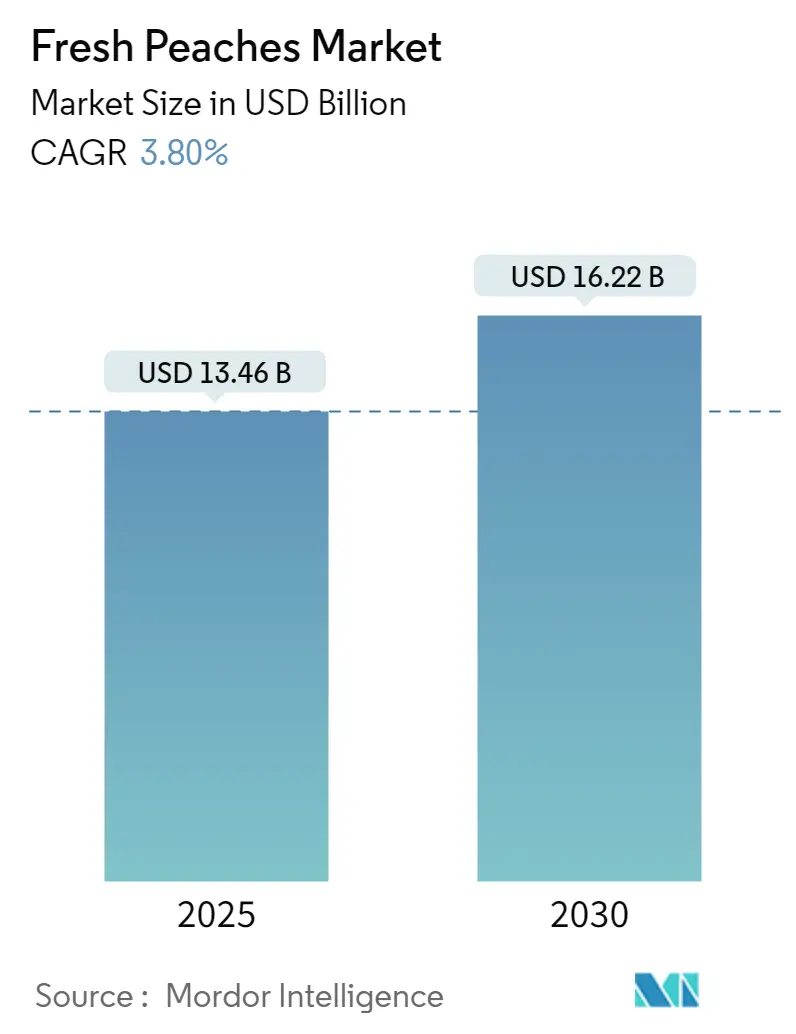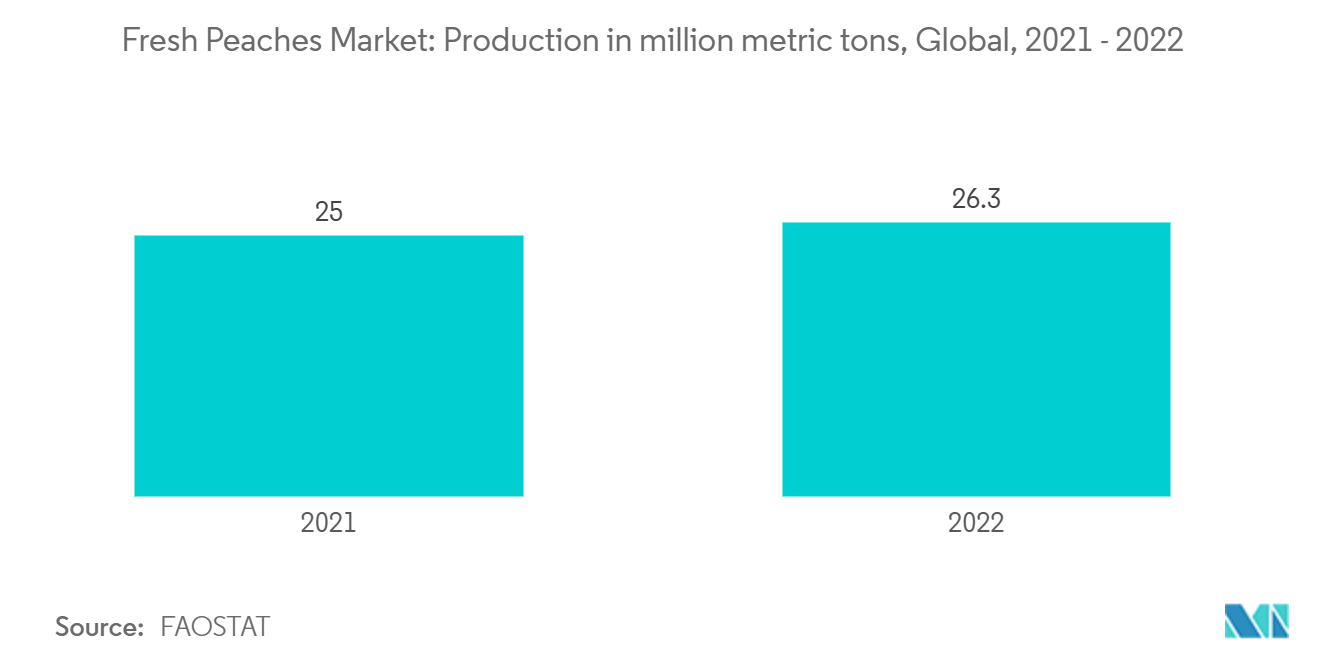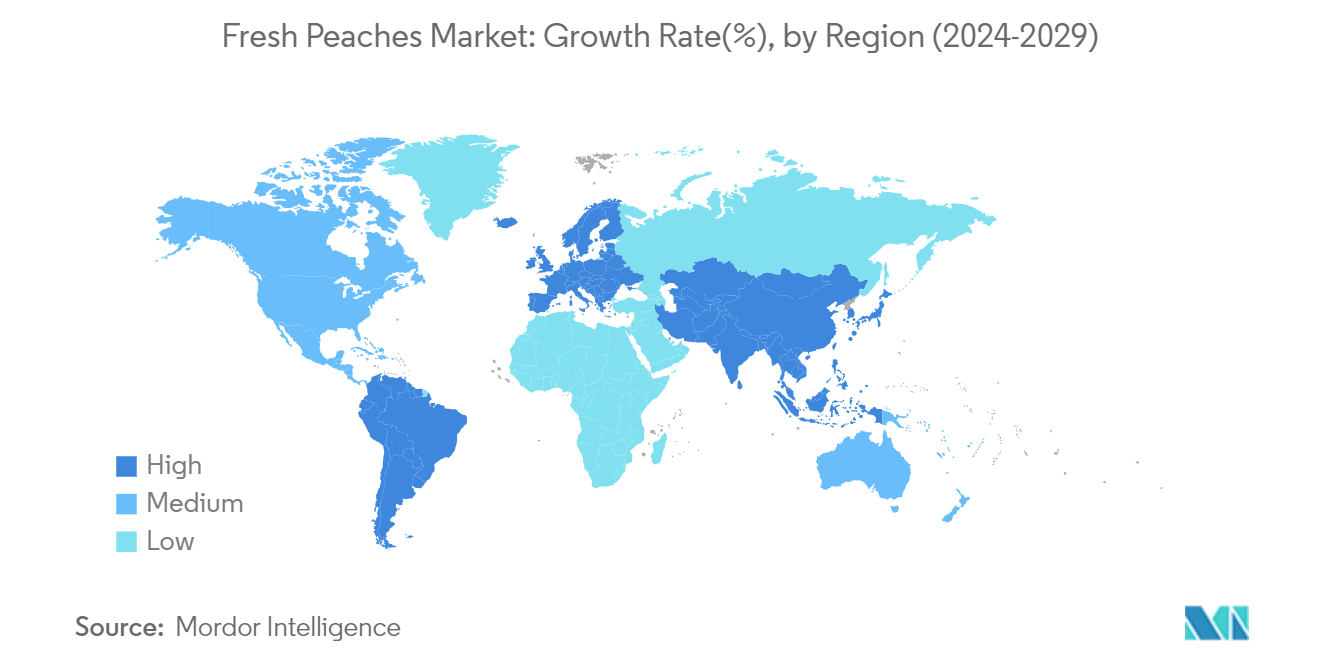Fresh Peaches Market Analysis
The Fresh Peaches Market size is estimated at USD 13.46 billion in 2025, and is expected to reach USD 16.22 billion by 2030, at a CAGR of 3.8% during the forecast period (2025-2030).
- Fresh peaches provide various health benefits, including immune system support, improved digestion, blood pressure regulation, and reduced risk of chronic diseases. Yellow-fleshed peaches are common in the United States, while white-fleshed varieties are more prevalent in Asian countries. Peaches are a major deciduous fruit crop globally, with significant production in China, Spain, Italy, and the United States.
- China's peach production is characterized by a lack of dominant brands, with popular varieties often named after their regions of origin, such as Long Quan Yi, Feng Hua, and Dang Shan peaches. Most farmers sell their produce through the Douyin online platform. However, the absence of branding results in limited sales promotions for peaches. Evolving consumer preferences are driving demand for new varieties and flavors. According to the USDA's Stone Fruit Annual 2023 report, imported peaches are gaining popularity in China's tier-1 cities.
- Technological advancements in cold chain logistics have enabled the long-distance transportation of perishable fruits like peaches without deterioration, making them available in non-producing countries. According to the ITC Trade Map, Spain exported 610,031 metric tons of peaches in 2023, a 13% increase from the previous year's export volume. The major importers are Germany, France, and Italy, accounting for 61% of Spain's peach export volume.
Fresh Peaches Market Trends
Advanced Farming Techniques are Fueling Peach Production
Agricultural technology advancements, including improved irrigation, pest control, and the development of new peach varieties, have led to higher crop yields and extended growing seasons, increasing the supply of fresh peaches. New varieties, such as the disease-resistant and climate-adaptable Felicia and Evelynn (yellow-fleshed) and Anna Rose (white-fleshed, released by Rutgers University in 2023), contribute to this growth. Notably, Evelynn shows low susceptibility to bacterial spot and increased cold hardiness compared to other varieties.
According to FAO data, global peach production reached 26.3 million metric tons in 2022, a 5.3% increase from the previous year's 25 million metric tons. China dominates production, contributing 63.7% of the global volume, followed by Spain (4%) and the USA (2%). The growing consumer awareness of healthy lifestyles has increased fresh fruit consumption, further driving the fresh peach market.
The rise in production has also led to increased processing of peaches into various products, including peach oil, puree, sorbets, and jams. Peach puree processing technology has extended the fruit's shelf life by converting it into liquid form. Additionally, greenhouse cultivation and organic peach production are significant factors driving market growth during the studied period.
Asia Pacific is the key player in the Fresh Peaches Market
Asia-Pacific is the largest and fastest-growing peach market globally. The region benefits from favorable growing conditions in most areas during the early season, resulting in high-volume harvests. China leads the region in both production and exports. In 2022, Russia lifted its import ban on Chinese fruits, quickly becoming the third-largest importer of Chinese peaches in MY 2022-2023. According to the USDA Stone Fruit Annual Report 2023, Kyrgyzstan, Vietnam, and Russia collectively accounted for over 80 percent of Chinese peach/nectarine exports in MY 2022/23.
China cultivates peaches across extensive areas due to favorable climatic conditions. The cultivation area is expanding annually, leading to increased production. FAOSTAT data shows that the peach cultivation area grew from 841,105 hectares in 2021 to 865,144 hectares in 2022. Additionally, yield improvements have further boosted production volumes. In 2022, the peach yield reached 19,438.5 kg/ha, a 2% increase from the previous year's 19,042.2 kg/ha.
Most peaches and nectarines in China are consumed fresh, with processed peach products (mainly juice/drinks, canned peaches, and preserved peaches) maintaining stable consumption levels. China is a major exporter of canned yellow peaches. The country also imports peaches to meet diverse consumer preferences. According to the USDA Stone Fruit Annual 2023 report, Chile and Australia are the primary suppliers of peaches to China, collectively accounting for 99% of China's peach imports in MY 2022-2023.
Fresh Peaches Market News
- August 2024: The application of modern agricultural technology has transformed peach cultivation in Yangshan Township, China. New cultivation methods have increased yield, reduced costs, and improved the efficiency of farmers. As a result, the local peach industry has flourished contributing significantly to the region's economy.
- July 2023: Rutgers University introduced three new peach varieties: Felicia, Evelynn, and Anna Rose. These varieties offer several advantages over traditional cultivars such as Redhaven, Klondike, and White Lady. The new varieties demonstrate improved firmness, enhanced sweetness, increased resistance to bacterial spot, and higher productivity.
Fresh Peaches Industry Segmentation
Peaches are sweet, juicy fruits widely consumed fresh and used in baked goods such as pies and cobblers. Rich in antioxidants and vitamin C, peaches contribute to strengthening immunity. As an important deciduous tree fruit, peaches have thousands of cultivated varieties. The Fresh Peaches Market is segmented geographically into North America, Europe, Asia-Pacific, South America, and Africa. The market report provides detailed analyses of production volume, consumption (volume and value), import (volume and value), export (volume and value), and price trends. Additionally, the report presents market size and forecast in both value (USD) and volume (metric tons).
| Geography | North America | United States | Production Analysis | |
| Consumption Analysis (Volume and Value) | ||||
| Import Market Analysis (Volume and Value) | ||||
| Export Market Analysis (Volume and Value) | ||||
| Price Trend Analysis | ||||
| Canada | Production Analysis | |||
| Consumption Analysis (Volume and Value) | ||||
| Import Market Analysis (Volume and Value) | ||||
| Export Market Analysis (Volume and Value) | ||||
| Price Trend Analysis | ||||
| Mexico | Production Analysis | |||
| Consumption Analysis (Volume and Value) | ||||
| Import Market Analysis (Volume and Value) | ||||
| Export Market Analysis (Volume and Value) | ||||
| Price Trend Analysis | ||||
| Europe | Germany | Production Analysis | ||
| Consumption Analysis (Volume and Value) | ||||
| Import Market Analysis (Volume and Value) | ||||
| Export Market Analysis (Volume and Value) | ||||
| Price Trend Analysis | ||||
| Poland | Production Analysis | |||
| Consumption Analysis (Volume and Value) | ||||
| Import Market Analysis (Volume and Value) | ||||
| Export Market Analysis (Volume and Value) | ||||
| Price Trend Analysis | ||||
| Italy | Production Analysis | |||
| Consumption Analysis (Volume and Value) | ||||
| Import Market Analysis (Volume and Value) | ||||
| Export Market Analysis (Volume and Value) | ||||
| Price Trend Analysis | ||||
| France | Production Analysis | |||
| Consumption Analysis (Volume and Value) | ||||
| Import Market Analysis (Volume and Value) | ||||
| Export Market Analysis (Volume and Value) | ||||
| Price Trend Analysis | ||||
| Turkey | Production Analysis | |||
| Consumption Analysis (Volume and Value) | ||||
| Import Market Analysis (Volume and Value) | ||||
| Export Market Analysis (Volume and Value) | ||||
| Price Trend Analysis | ||||
| Asia-Pacific | China | Production Analysis | ||
| Consumption Analysis (Volume and Value) | ||||
| Import Market Analysis (Volume and Value) | ||||
| Export Market Analysis (Volume and Value) | ||||
| Price Trend Analysis | ||||
| South Korea | Production Analysis | |||
| Consumption Analysis (Volume and Value) | ||||
| Import Market Analysis (Volume and Value) | ||||
| Export Market Analysis (Volume and Value) | ||||
| Price Trend Analysis | ||||
| Japan | Production Analysis | |||
| Consumption Analysis (Volume and Value) | ||||
| Import Market Analysis (Volume and Value) | ||||
| Export Market Analysis (Volume and Value) | ||||
| Price Trend Analysis | ||||
| India | Production Analysis | |||
| Consumption Analysis (Volume and Value) | ||||
| Import Market Analysis (Volume and Value) | ||||
| Export Market Analysis (Volume and Value) | ||||
| Price Trend Analysis | ||||
| South America | Brazil | Production Analysis | ||
| Consumption Analysis (Volume and Value) | ||||
| Import Market Analysis (Volume and Value) | ||||
| Export Market Analysis (Volume and Value) | ||||
| Price Trend Analysis | ||||
| Argentina | Production Analysis | |||
| Consumption Analysis (Volume and Value) | ||||
| Import Market Analysis (Volume and Value) | ||||
| Export Market Analysis (Volume and Value) | ||||
| Price Trend Analysis | ||||
| Chile | Production Analysis | |||
| Consumption Analysis (Volume and Value) | ||||
| Import Market Analysis (Volume and Value) | ||||
| Export Market Analysis (Volume and Value) | ||||
| Price Trend Analysis | ||||
| Africa | South Africa | Production Analysis | ||
| Consumption Analysis (Volume and Value) | ||||
| Import Market Analysis (Volume and Value) | ||||
| Export Market Analysis (Volume and Value) | ||||
| Price Trend Analysis | ||||
| Egypt | Production Analysis | |||
| Consumption Analysis (Volume and Value) | ||||
| Import Market Analysis (Volume and Value) | ||||
| Export Market Analysis (Volume and Value) | ||||
| Price Trend Analysis | ||||
Fresh Peaches Market Research FAQs
How big is the Fresh Peaches Market?
The Fresh Peaches Market size is expected to reach USD 13.46 billion in 2025 and grow at a CAGR of 3.80% to reach USD 16.22 billion by 2030.
What is the current Fresh Peaches Market size?
In 2025, the Fresh Peaches Market size is expected to reach USD 13.46 billion.
Which is the fastest growing region in Fresh Peaches Market?
Asia-Pacific is estimated to grow at the highest CAGR over the forecast period (2025-2030).
Which region has the biggest share in Fresh Peaches Market?
In 2025, the Asia Pacific accounts for the largest market share in Fresh Peaches Market.
What years does this Fresh Peaches Market cover, and what was the market size in 2024?
In 2024, the Fresh Peaches Market size was estimated at USD 12.95 billion. The report covers the Fresh Peaches Market historical market size for years: 2019, 2020, 2021, 2022, 2023 and 2024. The report also forecasts the Fresh Peaches Market size for years: 2025, 2026, 2027, 2028, 2029 and 2030.
Our Best Selling Reports
Fresh Peaches Industry Report
Statistics for the 2025 Fresh Peaches market share, size and revenue growth rate, created by Mordor Intelligence™ Industry Reports. Fresh Peaches analysis includes a market forecast outlook for 2025 to 2030 and historical overview. Get a sample of this industry analysis as a free report PDF download.





